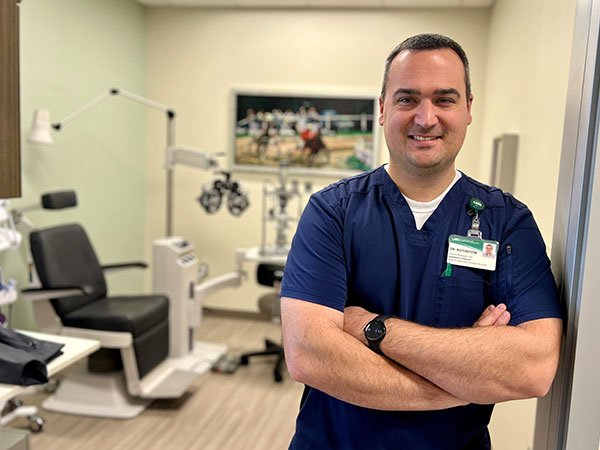by Nathan Anderson
Since UAB Eye Care’s 1917 Clinic location opened in 2022, 250 patients have received care. The success of this external location has paved the way for growth that will allow a greater number of patients to be seen there in the future.
The 1917 Clinic’s mission is to address the needs of patients, their families, doctors, researchers and the community in responding to the urgent and unique issues surrounding HIV/AIDS. It is the largest HIV healthcare unit in Alabama and one of the country’s leading HIV clinics.
“Given our newness at this location, we thought it would be best to start slowly to see how things went,” said Andrew Rothstein, OD, one of UAB Eye Care’s onsite attending doctors. “The 1917 Clinic turned out to be a resounding success. The demand was higher than expected, and before we knew it, we were completely booked for three months or more.
“The unsung heroes of the eye clinic’s success are the 1917 Clinic’s non-eye providers that continue to stress the importance of eye care to their patients. Without their referrals, many of these patients would not know the necessity of regular ocular health exams. This is particularly important in patients with HIV, as they have a high prevalence of ocular diseases, many of which are asymptomatic in the early stages.”
UAB Eye Care has had a longstanding referral-based relationship with the clinic, moving onsite once 1917 relocated to a larger building in 2020. Leadership sensed that having eye care onsite would provide comfort for patients already receiving care in the Dewberry building, increasing show rates and compliance.
Furthermore, optometry’s addition to the multidisciplinary clinic as an onsite healthcare provider helps detect patients’ eye conditions earlier and treat them onsite. Being in immediate proximity to patients, staff members can coordinate with other specialties to help treat patients with urgent eye care needs too.
“On several occasions, I have been able to consult with a patient’s infectious disease doctor, nurse or social worker simply by walking down the hall,” Rothstein said. “Students also benefit from these interactions and are able to shadow other disciplines if we have a light patient load for the day.”
Erika Marrs, class of 2024, said that working at the 1917 Clinic has allowed her to gain experience that would be rare to encounter anywhere else.
“We can see pathology that we wouldn’t normally get to see which is a great experience as a student,” Marrs said. “I have also enjoyed working with the patients in the clinic. They are very appreciative of our care and for providing a safe, comfortable environment for them.”
In preparation for the 1917 Clinic rotation, optometry students undergo specific training about the effects of HIV/AIDS on the eyes. Diversity, equity and inclusion education designed for this population is also required.
“The 1917 Clinic serves an incredibly diverse patient population,” Rothstein said. “While our students are well-rounded, completing diversity training specifically geared toward this clinic prepares them for their time with us. Studies have shown that patients who are part of the LGBTQ+ community are disproportionately affected by HIV, as are patients who identify as transgender. The students’ training addresses how to care for these populations specifically.”
In the future, Rothstein hopes to expand the number of days patients are seen during the week while creating more awareness for the optometry services offered at the 1917 Clinic.
